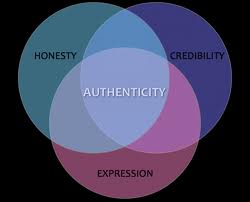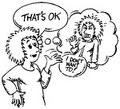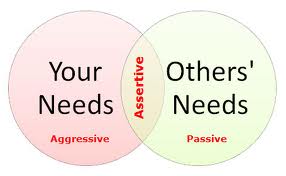Feelings are powerful. They dictate our actions, behaviours and beliefs – fact. They are so powerful that we have no control  over them – not fact. When we exercise power over our feelings we are choosing, to a much greater extent, how we feel. Our feelings are largely influenced by our thoughts and our thoughts are the result of our previous experiences, influences and beliefs in any situation. Therefore if you have learned to feel guilty if somebody around you is upset, you will most likely feel guilty. If your first reaction to perceived aggression is to retaliate in anger then you will become angry.
over them – not fact. When we exercise power over our feelings we are choosing, to a much greater extent, how we feel. Our feelings are largely influenced by our thoughts and our thoughts are the result of our previous experiences, influences and beliefs in any situation. Therefore if you have learned to feel guilty if somebody around you is upset, you will most likely feel guilty. If your first reaction to perceived aggression is to retaliate in anger then you will become angry.
So how can we go about reacting differently? The simplest way is to change our thoughts. And that’s where things become interesting. We have ultimate control over our thoughts. Nobody else has any power at all over them, unless we we give them that power. We can choose to perceive any situation, person or event in our own inimitable way. In order to change our thoughts we have to know that we are capable of doing so. If you believe a particular person will annoy you because he “always gets on my nerves” then chances are he is going to annoy you. If you tell yourself that he isn’t going to affect you anymore, you have a very strong chance that he won’t.
Give it a try. Next time you feel angry, sad, low, guilty, frustrated,  envious, upset or offended, don’t react, pause for thought. Literally. Be aware of what is going around your head, and then consider changing those thoughts. You can control your day to great effect if you get into the habit of re-thinking before re-acting.
envious, upset or offended, don’t react, pause for thought. Literally. Be aware of what is going around your head, and then consider changing those thoughts. You can control your day to great effect if you get into the habit of re-thinking before re-acting.
I would love to hear your comments about this or any other of my blogs. Please feel free to use the contact page.


 g? Your bosses? Your clients? Your childrens? Husbands? Parents? … or Yours? Who is the only person who can ever really know exactly what it is that ensures your happiness, peace of mind, contentment? And who is the only person who should really be expected to put in the time and commitment to ensure that happiness, peace of mind and contentment?
g? Your bosses? Your clients? Your childrens? Husbands? Parents? … or Yours? Who is the only person who can ever really know exactly what it is that ensures your happiness, peace of mind, contentment? And who is the only person who should really be expected to put in the time and commitment to ensure that happiness, peace of mind and contentment?

 ect
ect  our to live your life according to these and other similar principles, then you are living your life authentically. Living authentically means having an inner integrity and being honest and up-front with yourself, in order that you can be the same with others; being self-aware and understanding what you believe, want and feel. Living your life authentically means that you assess a situation before involving yourself, you sometimes put yourself first, and you only say what you really, honestly, truthfully mean.
our to live your life according to these and other similar principles, then you are living your life authentically. Living authentically means having an inner integrity and being honest and up-front with yourself, in order that you can be the same with others; being self-aware and understanding what you believe, want and feel. Living your life authentically means that you assess a situation before involving yourself, you sometimes put yourself first, and you only say what you really, honestly, truthfully mean.  rson you have become expected to be. When you live your life authentically, you become easier and less stressed to live with, happier to live with and kinder to live with. Authentic living is a win/win situation. So why not free all those thoughts and feelings around expectations of others and allow yourself to develop an inner wisdom in order to live your life through your inner self in a way that feels comfortable and right for you?
rson you have become expected to be. When you live your life authentically, you become easier and less stressed to live with, happier to live with and kinder to live with. Authentic living is a win/win situation. So why not free all those thoughts and feelings around expectations of others and allow yourself to develop an inner wisdom in order to live your life through your inner self in a way that feels comfortable and right for you? All too often we put ourselves on the line and over-extend ourselves in order to help somebody else conserve their time and energy! Of course there is nothing wrong in helping somebody because you want to and you choose to. A problem exists when you would prefer to say “no” but find yourself saying “yes”. Stress, anxiety and burnout are common allies of people who haven’t learned how to say “no” appropriately.
All too often we put ourselves on the line and over-extend ourselves in order to help somebody else conserve their time and energy! Of course there is nothing wrong in helping somebody because you want to and you choose to. A problem exists when you would prefer to say “no” but find yourself saying “yes”. Stress, anxiety and burnout are common allies of people who haven’t learned how to say “no” appropriately.

 on the other hand, is not good for anybody. It seeks to diminish the person you are angry at and at the same time diminishes you by making you feel bad. Even if you are able to justify your anger to yourself, you still have to convince other people that your behaviour is acceptable and that is not an easy task if your behaviour is inappropriate.
on the other hand, is not good for anybody. It seeks to diminish the person you are angry at and at the same time diminishes you by making you feel bad. Even if you are able to justify your anger to yourself, you still have to convince other people that your behaviour is acceptable and that is not an easy task if your behaviour is inappropriate. 
